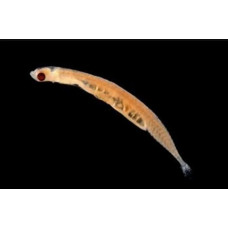Latin name
Schindleria brevipinguis
Other names
Schindleria brevipinguis
Identification
The appearance of this species is pedomorphic - adults resemble juveniles. This applies not only to the very small body size, but also to the details of the appearance. Schindleria brevipinguis has atrophied fins and lacks scales. The estimated life span of individuals of this species is only two months. Despite its very low weight, Schindleria brevipinguis differs from other species of the genus in having a more "dense" physique, as indicated by both its Latin species name (from the roots brevis - short - and pinguis - thick, massive) and its English name "stout infantfish". Vertebrae: 35-36. Body depth at the beginning of the pectoral fin is 9-12% of the standard length, and at the beginning of the anal fin is 9-14% of the average. The premaxillary and dento-mandibular muscles are not toothed. Males have a flexible rod-like urogenital papilla without lobes, protuberances or additional papillae, the distal half of which tapers towards the blunt end and usually points forward.
Features of fish fins
Dorsal soft rays (total): 13. Anal soft rays: 10-11.
Fish colouring
There is no pigmentation (the only coloured part of the body are the eyes).
Distribution
Schindleria brevipinguis is known from two isolated sites in the Great Barrier Reef area. The first is between Lizard Island and Carter's Reef and the second is near Osprey Reef in the Coral Sea, off the northern tip of the Great Barrier Reef.
Habitat
Subtropical marine species. They live in the euphotic zone at depths of 15 to 30 metres in close proximity to coral reefs.
Size
It is the smallest vertebrate. The average body length of a male is only 7.9 mm, that of a female with eggs 8.4 mm. The body weight is 1 mg.
Behavior
The population of these fish is quite dense: seven individuals per cubic metre.
Food and feeding habits
Prefers to feed on plankton.
Reproduction
Adults with mature gonads, retaining postlarval characteristics. Multiple mating. Becomes sexually mature two or three weeks after birth.
Fishing
It is very small and of no interest to fishermen.
Relationship with a person
A species harmless to humans.
| Classification | |
| Phylum | Chordata |
| Class | Actinopterygii |
| Squad | Gobiiformes |
| Family | Gobiidae |
| Genus | Schindleria |
| Species | S. brevipinguis |
| Features | |
| Conservation status | Least Concern |
| Habitat | Pelagic |
| Life span, years | 0,17 |
| Maximum body weight, kg | 0,000001 |
| Maximum length, cm | 0,84 |
| Sailing speed, m/s | No information |
| Threat to people | Not edible |
| Way of eating | Planktonophage |
Stout infantfish
Tags: stout infantfish



